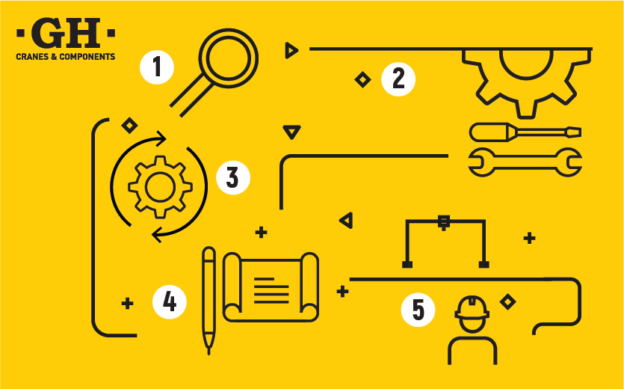La llegada del coronavirus ha supuesto un reto sin precedentes para todo el tejido empresarial mundial. Ante una realidad tan complicada, las empresas han tenido que adaptarse en un tiempo récord y maximizar sus recursos como nunca antes lo habían hecho. A pesar de ello, son muchas las empresas que desgraciadamente han visto frenada su producción.
A través de este artículo queremos señalar que, aunque es cierto que la situación actual no es la mejor, esta crisis es también una oportunidad para mejorar y potenciar el parque de grúas de las empresas sin que ello suponga perturbaciones en su producción. A continuación contamos cómo podemos ayudar desde GH Cranes & Components.
- Inspección y revisión de grúas.
Ahora que la producción se ha visto disminuida en muchos talleres y plantas industriales es un buen momento para prestar atención a la seguridad y revisar las grúas. En GH Cranes & Components disponemos de programas de inspección y mantenimiento personalizados para todas marcas de grúas y polipastos.
- Reparación de grúas
Son muchas las empresas que tenían pendiente reparar una grúa antes de la crisis y no encontraban el momento debido al exceso de trabajo. Desde GH Cranes & Componentes recomendamos aprovechar ahora que la producción se ha ralentizado para poner a punto todas las grúas. Para ello, contamos con técnicos especializados en la reparación de equipos de elevación.
- Actualización de grúas y montacargas
Sabemos que por culpa del coronavirus muchas empresas han visto reducido su presupuesto para nuevos compras. En esos casos, recomendamos aumentar el rendimiento de los equipos ya existentes con actualizaciones. Así, GH Cranes & Components ofrece servicios de modernización para todas las marcas de grúas.
- Planificación y diseño de proyectos de grúa.
En estos momentos que muchas empresas deben replantearse su futuro, cabe recordar que una grúa es un inversión a largo plazo capaz de optimizar el manejo materiales y aumentar la productividad. Así, en GH Cranes & Componentes tenemos un completo equipo de ingenieros y diseñadores preparados para convertir todos los planes en realidad.
- Optimización de la cadena de suministro
Las crisis ha hecho que cada pedido deba maximizarse al máximo, tanto en márgenes como en rentabilidad. Dado que ningún contratiempo debe frenar la producción, resulta fundamental asegurarse de tener en todo momento las piezas de repuesto y accesorios necesarios. Para optimizar las cadenas de suministros de las empresas, GH Cranes & Components ofrece repuestos OEM, repuestos de rendimiento y piezas de grúa equivalentes.
